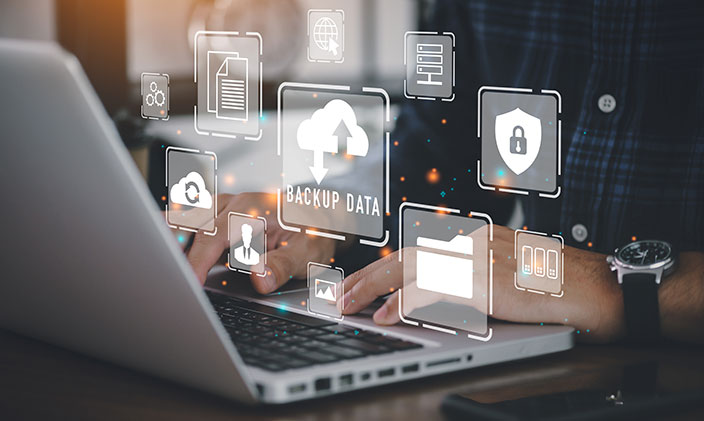Articles > Cybersecurity > Essential data security best practices
Essential data security best practices

Written by Michael Feder

Reviewed by Kathryn Uhles, MIS, MSP, Dean, College of Business and IT
Data can be considered a virtual representation of the physical world. And just like in the real world, there are crucial things people would like to keep secure from data breaches and prying eyes. With the number of types of cybersecurity threats increasing every day, the future of data depends on the security steps society takes to safeguard it today. Here's a closer look at the importance of data security best practices and strategies companiescan adopt to keep private information away from prying eyes.
What is data protection and why are data security best practices important?
Data security best practices are crucial in today’s digital world to keep information secure. Businesses in nearly every major industry rely on data for decision-making, forecasting and analysis. Furthermore, individuals are willing to provide personal data in exchange for the convenience of seamless access to services, such as instant online payments.
Data protection is the regulation and encryption of information from data breaches, corruption or compromise. For most people, data security focuses on securing and safeguarding information against hackers. However, other issues — such as having data lost or corrupted due to a storage device or database failure — are much more common.
There have been plenty of high-profile data breaches in recent times. The Mother of All Breaches (MOAB) took place in early 2024, exposing 12 terabytes of information representing 26 billion records with info like credentials and passwords for platform including Facebook, Google and Apple.
As more companies ask for private data to offer streamlined service to users, the future of security is going to be even more complicated than it is today.
According to the CIA, there are three main types of data security known as the “CIA triad.” These three types are confidentiality, integrity and availability. Respectively, these deal with encryption, tampering and availability, and all three pose major challenges to data security.
Three principles guide data security best practices, and understanding how the principles work together helps individuals and organizations better manage and protect their sensitive information:
- Data availability: Users should be able to access the data they need to perform their duties even when it’s damaged or lost.
- Data life-cycle management: Systems should continuously and automatically transmit newly generated data to offline and online storage facilities.
- Information life-cycle management: Raw data should be valued, categorized and then protected as an information asset. By assigning a value to data, data managers can decide how much protection is necessary. They can then protect valuable data from malware, media failure, user and application errors, outages, disruptions and natural disasters.
Data security best practices involves both security and access to information. The challenge, therefore, is to protect information while still making it easily accessible to those who need to use it.
Are there different types of data protection?
Data forms the backbone of many personal and business processes. Social media and e-commerce platforms use data to tailor online experiences, and businesses depend on data to perform analyses that inform critical decisions that affect their bottom lines.
Data protection is a broad security field, but here are three major aspects that form the basis for all data security best practices:
- Controlling access: Only those authorized to access a specific piece of data should be able to view it.
- Ensuring portability: Data should be easy to transfer securely across a network, from one location or system to another without risking loss or compromise.
- Guaranteeing recovery and restoration: In the event of data loss, it should be possible to recover all the data from a backup and restore it as quickly as possible so that there are no operational or service interruptions.
Defining a company's security needs is the first step in adopting an effective strategy.
What data needs to be protected?
Data comes in different types. Some types need a significant amount of protection, and others do not.
For example, information about the weather forecast or the location of the local library does not need to be hidden. On the other hand, the wrong people should not have access to home addresses, ID numbers or debit card PINs.
Different types of data are considered private at an individual and institutional level. It’s impossible to list every data type a company might want to use encryption to protect, but here are the most common examples:
- Names
- Addresses
- Telephone numbers
- Bank and credit card details
- Health information
- Intellectual property, such as design for a proprietary device
- Financial Information
Governments also have sensitive data, such as military intelligence, that they need to protect with the highest levels of security.
How to protect personal and business data
Companies have cybersecurity teams that create IT risk management policies that include security strategies using data security best practices. However, data security is not only for corporations. Individuals can also take steps to protect their personal information and ensure it’s accessible when they need it.
Here are the steps to take to protect personal and business data:
1. Understand data technologies and databases
It’s essential to understand the systems involved in data protection. Here are the primary components of data management:
- Database: Generally speaking, a database is nothing more than a mass of information sitting on a server or storage device. This data may be structured in various ways and serve different purposes. Individuals can use applications or software to access or organize the data.
- SQL: Structured Query Language, known as SQL, is a specification for the language used to program, modify or help secure databases. Hackers sometimes find vulnerabilities in SQL code that they exploit to gain access to sensitive data.
- File systems: File systems allow users to access and share information within a secured system. Different operating systems have different file systems. Many people in nontechnical positions within a company use file systems to access and share information.
To be on the front lines of data security, aspiring data security professionals likely will need to pursue a technology degree. For example, a Bachelor of Science in Computer Science teaches data security best practices and fundamental skills used in a data management career. Meanwhile, an IT degree offers more hands-on education in systems and tools for data management and protection.
2. Be able to identify sensitive data
Companies don’t want to spend time and resources protecting data that isn’t sensitive. It’s essential to know what qualifies as sensitive in this context. Intellectual property, business intelligence or analysis, and personal identifiers, such as Social Security numbers or addresses, typically qualify as sensitive data.
While it’s possible to manually classify data that needs protection, this isn’t always necessary. Data discovery and classification technologies use automated queries to find specific data, such as phone numbers or Social Security numbers. The system can then place the proper protection protocols on that information.
3. Create efficient data usage policies
Data protection includes having a clear policy on who can access what data and under what conditions. Companies also have to define how employees or third parties can use the data. Cybersecurity and data security best practices should also be clear to everyone who has access to networks with sensitive data because one unsecured or malware-infected device can compromise the data on the entire network.
4. Control access to sensitive data
In most cases, the best policy is to give employees access to the data they need to perform their duties and nothing else. There are several ways to control access including keycards and other systems to limit access to the physical server room where data is stored.
Companies can also restrict the use of hard drives or online storage to limit the ability to copy sensitive data. A well-partitioned database system can also limit digital access. Finally, companies can implement termination protocols, which define the steps that the company takes to ensure employees cannot access protected data after they quit.
5. Use data encryption
Data encryption is the conversion of information into a form that prevents unauthorized access. Encrypted data appears as a nonsensical collection of words and numbers unless a user has a decryption key, which converts it into a readable format. Sensitive data should always be encrypted before transmission or storage.
6. Perform regular data backups
Protecting against data loss is an important aspect of data management. Backups ensure the existence of several copies of data. If one copy is destroyed or compromised, the other can be accessed. Efficient database and file management systems use continuous backups. Also known as continuous data protection (CDP) this data security best practice refers to the encryption or backup of computer data in real time through a system that automatically saves a copy of data every time a change is made. CDP makes it possible to restore a system to any previous point in time after a change was made, even if it wasn't physically saved or backed up. This feature, also known as mirroring, ensures it’s always possible to restore data when it's lost it.
Ready for a deeper dive into data security best practices?
Interested in knowing more about data security best practices or a career in data protection? University of Phoenix offers an online cybersecurity degree that helps to prepare graduates for work in the field.
Contact an enrollment representative for more information.

ABOUT THE AUTHOR
A graduate of Johns Hopkins University and its Writing Seminars program and winner of the Stephen A. Dixon Literary Prize, Michael Feder brings an eye for detail and a passion for research to every article he writes. His academic and professional background includes experience in marketing, content development, script writing and SEO. Today, he works as a multimedia specialist at University of Phoenix where he covers a variety of topics ranging from healthcare to IT.

ABOUT THE REVIEWER
Currently Dean of the College of Business and Information Technology, Kathryn Uhles has served University of Phoenix in a variety of roles since 2006. Prior to joining University of Phoenix, Kathryn taught fifth grade to underprivileged youth in Phoenix.
This article has been vetted by University of Phoenix's editorial advisory committee.
Read more about our editorial process.
Get your free IT Program Guide
Learn how 100% of our IT degree and certificate programs align with career-relevant skills.
Get your free IT program guide. Please enter your first and last name.
Thank you
Download your pdf guide now. Or access the link in our email.


